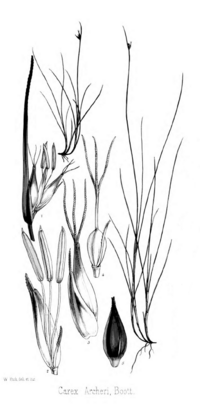Biology:Carex archeri
| Carex archeri | |
|---|---|

| |
| 1859 illustration of C. archeri by Walter Hood Fitch | |
| Scientific classification | |
| Kingdom: | Plantae |
| Clade: | Tracheophytes |
| Clade: | Angiosperms |
| Clade: | Monocots |
| Clade: | Commelinids |
| Order: | Poales |
| Family: | Cyperaceae |
| Genus: | Carex |
| Subgenus: | Carex subg. Vignea |
| Section: | Carex sect. Inversae |
| Species: | C. archeri
|
| Binomial name | |
| Carex archeri Boott [1]
| |
| Synonyms [2] | |
| |
Carex archeri, known as Archer's sedge,[3] is a species of sedge in the genus Carex, endemic to south-eastern Australia .
Description
Carex archeri grows up to 25 centimetres (10 in) high, with leaves less than 0.5 millimetres (0.02 in) wide.[4] Its inflorescence comprises a single spike subtended by a bract that is longer than the inflorescence. The spike contains few flowers, with the female flowers towards the base of the spike, and a very short portion towards the tip containing male flowers.[4] The glumes of the female flowers are 2.5–4.0 mm (0.098–0.157 in) long, and the utricles that form in the female flowers are 3–5 mm (0.12–0.20 in) long, with a 1.3–2.5-millimetre (0.05–0.10 in) notched beak.[4]
Specimens of C. archeri may be mistaken for stunted examples of either of two species classified in the same section, C. raleighii and C. hebes.[4]
Distribution and ecology
Carex archeri grows in bogs, alpine heath and tussock grassland in upland areas of Tasmania and the Australian Alps of Victoria and New South Wales.[4][5] Within New South Wales, it is limited to parts of Kosciuszko National Park around Club Lake and the upper reaches of the Thredbo River.[5]
Conservation
Carex archeri is not listed on the Environment Protection and Biodiversity Conservation Act 1999,[6] but it is subject to protection by the state of New South Wales as an endangered species,[5] and as a vulnerable species in Victoria.[3]
Taxonomy
Carex archeri was first described by Francis Boott in 1858,[3] and named in honour of William Archer.[7] Archer had collected the type material in the western mountains of Tasmania.[1]
References
- ↑ 1.0 1.1 F. Boott. "Gen. XV. Carex, L.". in J. D. Hooker. Flora Tasmaniæ, Botany of Tasmania. Volume II. Monocotyledones and Acotyledones. pp. 98–102. https://www.digitale-sammlungen.de/en/view/bsb10229753?page=110.
- ↑ "Cyperaceae". Australian Plant Census. Council of Heads of Australasian Herbaria. http://www.chah.gov.au/apc/interim/Cyperaceae.pdf. Retrieved 6 December 2014.
- ↑ 3.0 3.1 3.2 "Carex archeri Boott: Archer's Sedge". Atlas of Living Australia. Archived from the original on 10 December 2014. https://web.archive.org/web/20141210194449/http://bie.ala.org.au/species/urn%3Alsid%3Abiodiversity.org.au%3Aapni.taxon%3A739409. Retrieved 6 December 2014.
- ↑ 4.0 4.1 4.2 4.3 4.4 "Carex archeri Boott". eMonocot. http://cyperaceae.e-monocot.org/cyperaceae/carex-archeri. Retrieved 6 December 2014.
- ↑ 5.0 5.1 5.2 "Archer's Carex - profile". Threatened species. New South Wales Office of Environment and Heritage. http://www.environment.nsw.gov.au/threatenedspeciesapp/profile.aspx?id=10147. Retrieved 6 December 2014.
- ↑ Keith L. McDougall & Neville G. Walsh. "Treeless vegetation of the Australian Alps". Royal Botanic Gardens, Sydney. http://www.rbgsyd.nsw.gov.au/__data/assets/pdf_file/0004/85063/Cun101001McD.pdf. Retrieved 6 December 2014.
- ↑ J. H. Maiden (1909). "Records of Tasmanian botanists". Proceedings of the Royal Society of Tasmania: 9–29. http://core.kmi.open.ac.uk/download/pdf/12189822.pdf. Retrieved 2014-12-06.
Wikidata ☰ Q2938250 entry
 |

